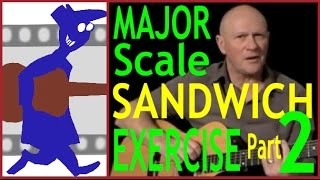Jazz Guitar for Beginners - Melody
Published on 26 January 2016
For more information from the source site of this video please visit:
http://secretguitarteacher.com/youtube/beginner/jazz/n8cmmXOyYFI/112564558-jazz-guitar-for-beginners-melody.php
This is a sample of a lesson from the Secret Guitar Teacher site (see link above).
This lesson comes from the Beginners Jazz Course designed for those who would prefer to learn Jazz right from the start instead of taking the more commonly-trodden path of playing blues or rock guitar for a few years first. So this lesson assumes no prior knowledge or experience of playing the guitar.
Here’s the abridged transcript:
Now in this lesson we are going to work on the necessary preparatory steps to enable you to play the melody part or ‘lead’ part of jazz pieces. Much of the work we’ll do also helps set you up for the third line of development that this course focuses on - the ability to improvise jazz solos.
First we need to get the fingers of our fretting hand working as a team, and the best way to do this is to take the basic exercises taught in the Secret Guitar Teacher's Gym section of the site and play them with a syncopated rhythm. So for example, the Easy Warm up exercise, which we normally play like this, we play instead like this.
The difference between straight rhythm and syncopated rhythm is simply that when playing straight each note lasts exactly the same length of time. Syncopation or ‘swing’ as its more often called in Jazz circles, means that for each pair of notes, we lengthen the first at the expense of the second. So instead of 1 & 2 & 3 & 4 & we count 1 a 2 a 3 a 4 a …and notice that the long notes are played on downstrokes and the shortened notes are played on the upstrokes.
Now it must be appreciated that we have designed this course to meet the needs of quite a wide range of abilities. So I want to stress that these exercises will be very tough if you are a complete beginner and that you should expect to put in several months of hard work to get them up to the sort of speed demonstrated here.
In this case, I advise starting out without the metronome, but once you have the basic exercise learnt, set the metronome at no more than 52 bpm for your first attempts. Then, as soon as you feel you are playing the exercise with good sound quality at that speed, notch it up no more than 8 beats per minute at a time so that you increase speed gradually and keep your attention on good sound production and most importantly of all a smooth steady beat to your playing.
OK on to the next step. Using these basic exercises as warm-ups every time you pick up the guitar will soon get you to a stage where you can play scale patterns.
It’s a good idea to learn this one string at a time. Starting with the G string we play that open, that means without any fingering, then using our second finger we play the note at the 2nd fret and using our 3rd finger the note at the third fret. This is what we call an open position scale pattern, and one advantage of that is that the finger numbers and fret numbers coincide. So we can just refer to this pattern as ‘open 2 3’.
Now learning a scale pattern is just a beginning. Once you have memorised it, it’s a great idea to spend about 15 minutes or so just messing about with it. This is what I mean. Start by playing it steadily up and down straight. Then just pick two or three notes in a row from the scale and repeat them in random order then move on to another part of the scale and do the same.
Pay particular attention to bits of scale that work on adjoining strings come back down the scale doing the same sort of thing, just working with two or three adjacent notes at a time in random fashion.
Now still sticking to just two or three notes at once, start increasing the gaps between the notes jump from third to top string or back the other way. Use one note as what’s called a ‘pedal’ repeatedly bounce off it onto other notes like this.
Finally, deliberately do all this with a swing rhythm. Attempt to keep a steady stream of phrases going without missing a single beat or hitting any notes from outside of the scale.
This is a great exercise to really get a scale pattern into your head, your fingers, and your ears. Gradually you’ll really begin to identify the sound of the pattern.
Ok, so that’s all for this lesson. We’ve looked at the basics of comping in our first lesson and now we have laid the foundations for lead or melody playing.
In the next lesson we are going to initiate you into the mysterious subject of Jazz improvising.
I look forward to seeing you for that.
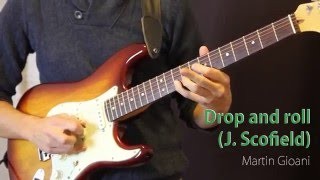 Drop and Roll : improvisation (John Scofield)
Drop and Roll : improvisation (John Scofield)
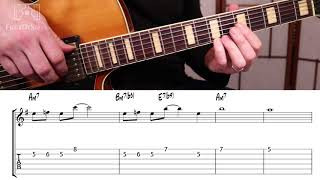 Out Of Nowhere - Learn The Melody - Jazz Guitar Le...
Out Of Nowhere - Learn The Melody - Jazz Guitar Le...
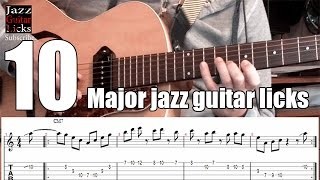 10 easy major jazz licks - Jazz guitar lessons wit...
10 easy major jazz licks - Jazz guitar lessons wit...
 Blues Lick in G (With Tab) - Guitar Lesson - Camil...
Blues Lick in G (With Tab) - Guitar Lesson - Camil...
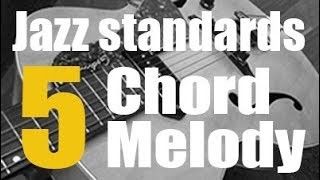 Guitar Lesson - 5 jazz standards arranged for chor...
Guitar Lesson - 5 jazz standards arranged for chor...
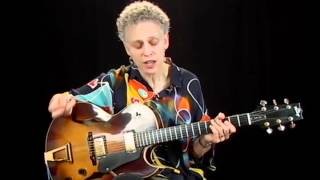 Jazz Performance - #12 Octaves - Guitar Lesson - M...
Jazz Performance - #12 Octaves - Guitar Lesson - M...
 Nice Rhythm Turns Nasty Fuzz | Syncopation | Tim P...
Nice Rhythm Turns Nasty Fuzz | Syncopation | Tim P...
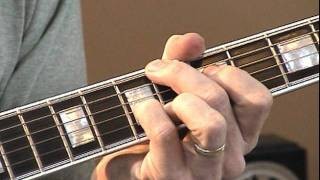 How to play 112 Jazz Guitar Chords (HD)
How to play 112 Jazz Guitar Chords (HD)
 Tony Monaco, Tom Braxton & Fareed Haque performing...
Tony Monaco, Tom Braxton & Fareed Haque performing...
 Gibson Les Paul vs Epihone Les Paul vs Gibson SG:...
Gibson Les Paul vs Epihone Les Paul vs Gibson SG:...


